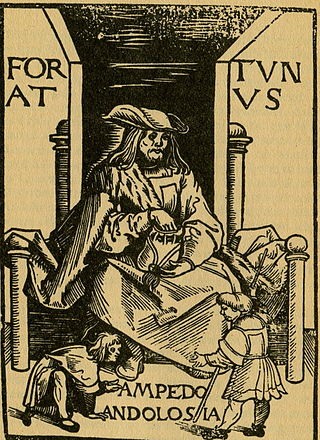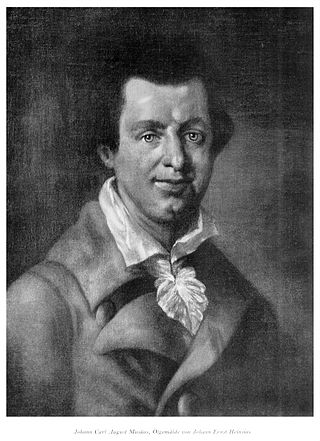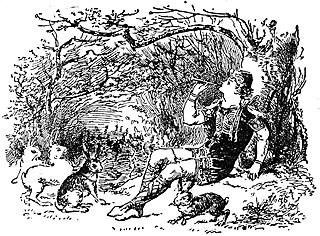E Bukura e Dheut is a character in Albanian mythology and folklore, depicted in some traditions as a crafty fairy, and in other traditions as a chthonic/earth goddess, the counterpart of e Bukura e Detit and i Bukuri i Qiellit. In some Albanian traditions she is regarded as the sister of e Bukura e Detit and the consort of Baba Tomor.

Fortunatus is a German proto-novel or chapbook about a legendary hero popular in 15th- and 16th-century Europe, and usually associated with a magical inexhaustible purse.

Johann Karl August Musäus was a German author. He was one of the first collectors of German folk stories, most celebrated for his Volksmärchen der Deutschen (1782–1787), a collection of German fairy tales retold as satires.
Drakestail also known as Quackling is a Fairy tale about a duck, where repetition forms most of the logic behind the plot. The story is also similar to other folk and fairy tales where the hero picks up several allies and uses them in the exact order found.

"The Three Spinners" is a German fairy tale collected by the Brothers Grimm in Grimm's Fairy Tales. It is Aarne–Thompson type 501, which is widespread throughout Europe.

"The Master Maid" is a Norwegian fairy tale collected by Peter Christen Asbjørnsen and Jørgen Moe in their Norske Folkeeventyr. "Master" indicates "superior, skilled." Jørgen Moe wrote the tale down from the storyteller Anne Godlid in Seljord on a short visit in the autumn of 1842. Andrew Lang translated the tale to English and included it in his The Blue Fairy Book (1889). A later translation was made by George Dasent, in his Popular Tales from the North.

"The Master Thief" is a Norwegian fairy tale collected by Peter Chr. Asbjørnsen and Jørgen Moe. The Brothers Grimm included a shorter variant as tale 192 in their fairy tales. Andrew Lang included it in The Red Fairy Book. George Webbe Dasent included a translation of the tale in Popular Tales From the Norse.

The Story of Pretty Goldilocks or The Beauty with Golden Hair is a French literary fairy tale written by Madame d'Aulnoy. Andrew Lang included it in The Blue Fairy Book.

Princess Belle-Etoile is a French literary fairy tale written by Madame d'Aulnoy. Her source for the tale was Ancilotto, King of Provino, by Giovanni Francesco Straparola.

"The Brave Little Tailor" or "The Valiant Little Tailor" or "The Gallant Tailor" is a German fairy tale collected by the Brothers Grimm. "The Brave Little Tailor" is a story of Aarne–Thompson Type 1640, with individual episodes classified in other story types.
The Wonderful Tune is an Irish fairy tale collected in Thomas Crofton Croker's Fairy Tales and Traditions of the South of Ireland (1825–28). Andrew Lang included it in The Lilac Fairy Book, and
Morgens, morgans, or mari-morgans are Welsh and Breton water spirits that drown men.
King Kojata or The Unlooked for Prince or Prince Unexpected is a Slavonic fairy tale, of Polish origin. Louis Léger remarked that its source was "one of the most important collections of Polish literature".

Long, Broad and Sharpsight or Long, Broad, and Quickeye is a Bohemian fairy tale, collected and published by Karel Jaromír Erben in 1865 in Sto prostonarodních pohádek a pověstí slovanských and also by Louis Léger in Contes Populaires Slaves.

Jesper Who Herded the Hares is a Scandinavian fairy tale, first recorded by Danish folktale collector Evald Tang Kristensen in the first volume of Æventyr fra Jylland. Andrew Lang included it in The Violet Fairy Book.
The Gifts of the Magician is a Finnish fairy tale, first published by Eero Salmelainen. This tale, in particular, is actually titled Paholaisen antamat soittoneuwot [soittoneuvot]. It was translated into German by Emmy Schreck as Die Gaben des Unholds. Andrew Lang included it in The Crimson Fairy Book (1903), listing his source as Finnische Mahrchen.
Le Serpentin Vert is a French fairy tale written by Marie Catherine d'Aulnoy, popular in its day and representative of European folklore, that was published in her book New Tales, or Fairies in Fashion, in 1698. The serpent is representative of a European dragon. His description is: "he has green wings, a many-coloured body, ivory jaws, fiery eyes, and long, bristling hair."
Fairer-than-a-Fairy is a literary fairy tale published anonymously in the 1718 fairy tale collection Nouveaux contes de fées. It is attributed to the Chevalier de Mailly. Andrew Lang included it in The Yellow Fairy Book.
Monyohe is a character that appears in folktales from the Sotho people. He sometimes is depicted as a serpentine or snake being with invisible powers that marries a human woman.
The Child with a Moon on his Chest is a South African folktale from the Sotho people. It is related to the cycle of the Calumniated Wife, and is classified in the international Aarne-Thompson-Uther Index as tale type ATU 707, "The Three Golden Children".









